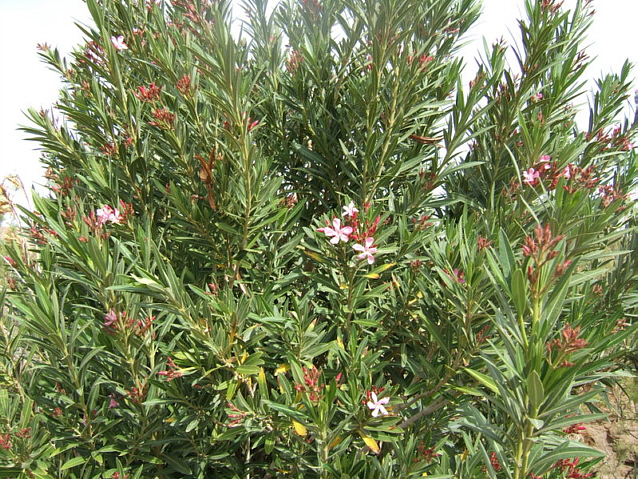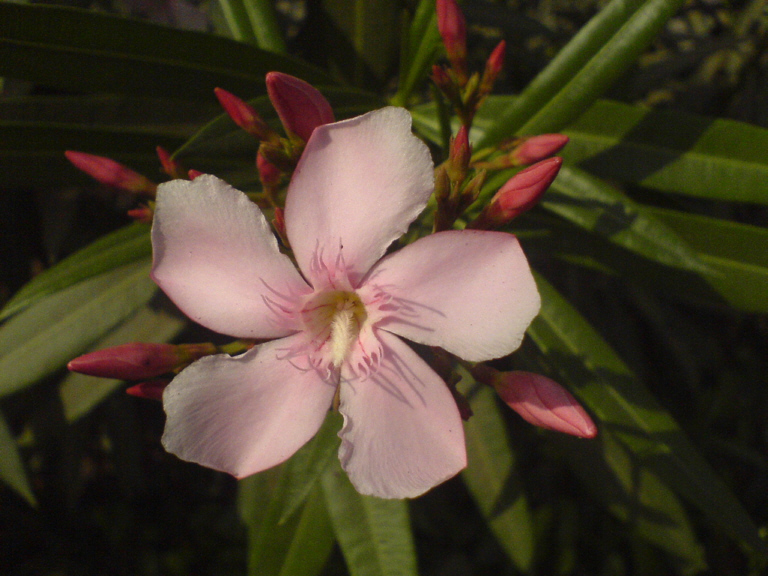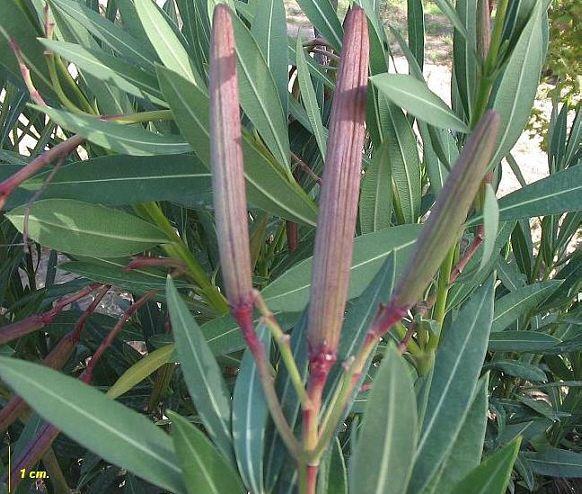

Zitierweise / cite as:
Carakasaṃhitā: Ausgewählte Texte aus der Carakasaṃhitā / übersetzt und erläutert von Alois Payer <1944 - >. -- Anhang A: Pflanzenbeschreibungen. -- Nerium oleander L. -- Fassung vom 2007-06-29. -- URL: http://www.payer.de/ayurveda/pflanzen/nerium_oleander.htm
Erstmals publiziert: 2007-06-27
Überarbeitungen: 2007-06-29 [Ergänzungen]
Anlass: Lehrveranstaltung SS 2007
©opyright: Dieser Text steht der Allgemeinheit zur Verfügung. Eine Verwertung in Publikationen, die über übliche Zitate hinausgeht, bedarf der ausdrücklichen Genehmigung des Verfassers
Dieser Text ist Teil der Abteilung Sanskrit von Tüpfli's Global Village Library
WARNUNG: dies ist der Versuch einer
Übersetzung und Interpretation eines altindischen Textes. Es ist keine
medizinische Anleitung. Vor dem Gebrauch aller hier genannten Heilmittel wird
darum ausdrücklich gewarnt. Nur ein erfahrener, gut ausgebildeter ayurvedischer
Arzt kann Verschreibungen und Behandlungen machen!
Falls Sie die diakritischen Zeichen nicht dargestellt bekommen, installieren Sie eine Schrift mit Diakritika wie z.B. Tahoma.
Verwendete und zitierte Werke siehe: http://www.payer.de/ayurveda/caraka0001.htm
Nerium oleander L. = Nerium indicum Mill. = Nerium odorum Soland ex Ait. ("Die früher vertretene Auffassung, bei den in Asien vorkommenden Wildformen handele es sich um eine eigene Art (Nerium indicum) wird wegen der zu geringen Unterschiede im Phänotyp heute nicht mehr bestätigt." Wikipedia)
gr. nērion (Oleander); frz. oléandre / ital. oleandro
Apocynaceae - Hundsgiftgewächs
"Oleander ist eine immergrüne verholzende Pflanze. Er hat lanzettförmige, ledrige, etwa 6 bis 10 cm lange dunkelgrüne Blätter, die normalerweise zu dritt, quirlförmig angeordnet, am Ast stehen. Die Blüten stehen zu mehreren in Trugdoldenblüte. Die zwittrigen Blüten sind fünfzählig. Die Blütezeit erstreckt sich von Mitte Juni bis in den September hinein. Die Blüte ist, je nach Sorte und Züchtung, weiß, gelblich oder in verschiedenen Rosa- bis Violetttönen." (Wikipedia)
karavīra: Caraka I,5,73 (dantaśodhana)
karavīra
śatakumbha
aśvamāraka
caṇḍāta
laguḍa
dt. Oleander, Rosenlorbeer
engl. Oleander, Rose Bay
Inhaltsstoffe der Blätter: Herzglykoside (Oleandrin, Oleandrigenin, Desacetyloleandrin, Adynerin, Neriantin), Neriin (diuret. wirkend), Rutin, Saponin, Gerbstoffe, Harz, ätherisches Öl;
Bhāvaprakāśa: I, S. 240
Pandey: II, S. 141ff.
Hunnius: s.v.
Wikipedia:
http://de.wikipedia.org/wiki/Oleander. -- Zugriff am 2007-05-07
http://en.wikipedia.org/wiki/Oleander. -- Zugriff am 2007-05-07

Abb.: Nerium oleander L. - Oleander, Marokko
[Bildquelle: Wikipedia]

Abb.: Nerium oleander L. - Oleander
[Bildquelle:
dinesh_valke. --
http://www.flickr.com/photos/dinesh_valke/331691820/. -- Zugriff am
2007-06-29. --
![]()
![]()
![]() Creative
Commons Lizenz (Namensnennung, keine kommerzielle Nutzung, keine
Bearbeitung)]
Creative
Commons Lizenz (Namensnennung, keine kommerzielle Nutzung, keine
Bearbeitung)]

Abb.: Nerium oleander L. - Oleander, Früchte
[Bildquelle: Wikipedia]
Drury:
"Nerium odorum (Ait.) N. O. Apocynaceae
- Sweet-scented Oleander, Eng.
- Tsjovanna Aralee, Mal.
- Aralee, Tam.
- Ghenneru, Tel.
- Kaneer, Duk.
- Kaner, Hind.
- Lal-kharubee, Beng.
Description.—Shrub, 6-8 feet; calyx 5-cleft; corolla salver-shaped, throat crowned by lacerated segments, segments of the limb twisted, unequal - sided; leaves linear lanceolate, 3 in a whorl, veiny beneath, with revolute edges; peduncles terminal; flowers pale-red, fragrant; follicles cylindrical Fl. June— Aug.—Roxb. Fl. Ind. ii. 2.—Rheede, ix. t. 1-2.------Near banks of rivers. Common in gardens.
Medical Uses.—There are two or three varieties with deep red, white, rose-coloured, single and doable flowers. The bark of the root is used externally as a powerful repellent, and made into a paste is applied in cases of ringworm. The root itself taken internally acts as a poison.—(Ainslie.) The root contains a yellow poisonous resin, tannic acid; wax, and sugar, but no alcaloid or volatile poison. The same poison resides in the hark and flowers. It is very soluble in carbonate of soda, and, though not volatile, is carried off mechanically when the plant is distilled with water. It is used in leprosy, eruptions of the skin, and boils.—Powells Punj. Plants."
[Quelle: Drury, Heber <1819 - 1872>: The useful plants of India : with notices of their chief value in commerce, medicine, and the arts. -- 2d ed. with additions and corrections. London : Allen, 1873. -- xvi, 512 p. ; 22 cm. -- s.v.]
Dutt:
"NERIUM ODORUM, Solander. Sans. Karavira. Asvamāraka.
Fern. Karabi, Beng. Kaner, Hind.
Two varieties of Karavira are described in the Bhāvaprakāsa, namely white and red flowered. The properties of both are identical, their roots being regarded as poisonous when taken internally and useful in skin diseases and inflammatory affections. The Nerium odorum has several synonyms in Sanskrit signifying horse-killer. It would seem from this, that the poisonous roots were used for destroying horses.
Karavirādya taila. Take of sesamum oil four seers, decoction of the root of Nerium odorum, eight seers, cow's urine, eight seers, Plumbago rosea root and bāberang seeds, each half a seer, in the form of a paste ; boil them together and prepare an oil in the usual way. This oil is used in eczema, impetigo and other skin diseases.
The root of Nerium odorum beaten into a paste with water is recommended to be applied to chancres and ulcers on the penis. The fresh juice of the young leaves is poured into the eyes in ophthalmia with copious lachrymation."
[Quelle: Dutt, Uday Chand: The materia medica of the Hindus / Uday Chand Dutt. With a glossary of Indian plants by George King. -- 2. ed. with additions and alterations / by Binod Lall Sen & Ashutosh Sen. -- Calcutta, 1900. - XVIII, 356 S. -- S. 191.]